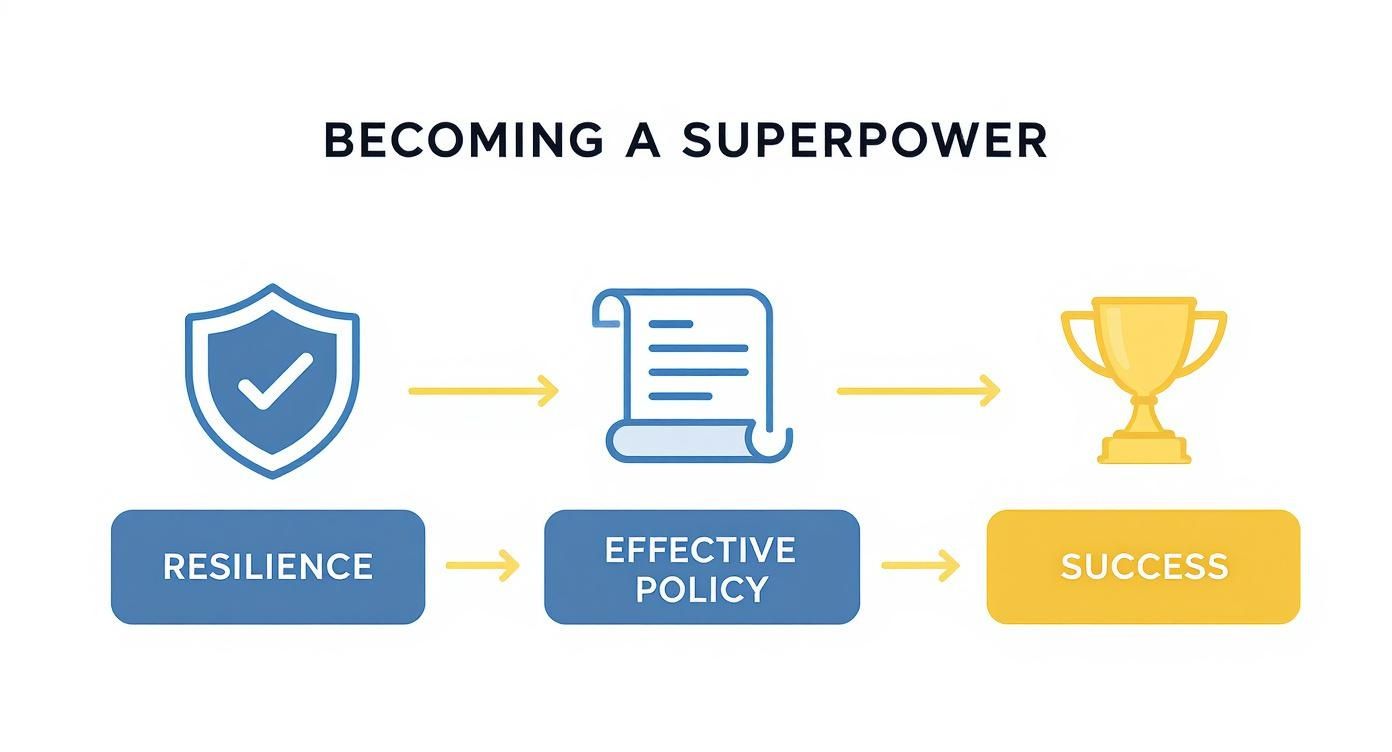Ever heard the phrase "can't see the forest for the trees"? That’s the exact problem systems thinking solves. At its heart, it’s a way of looking at the big picture—seeing how all the different pieces of a puzzle fit together and influence each other, instead of just staring at one piece at a time.
Seeing The Whole Picture

Think about a chronic traffic jam. If you only focus on one busy intersection, you might install a new traffic light. But that simple "fix" could easily just push the bottleneck a few blocks down the road, creating an even bigger mess. You treated a symptom, not the root cause.
Systems thinking asks you to zoom out. Instead of one intersection, you start to see the whole city's road network, the public transit lines, and where people are actually trying to go. You stop looking at problems as a simple line of cause-and-effect and start seeing them as a complex web of relationships.
"Systems thinking is a discipline for seeing wholes. It is a framework for seeing interrelationships rather than things, for seeing patterns of change rather than static snapshots."
This shift in perspective is game-changing. Most of the tough challenges we face, whether it’s a stubborn software bug or a sudden drop in team morale, aren't isolated events. They're symptoms of deeper, interconnected dynamics at play.
From Parts to Patterns
Our go-to problem-solving method is often to break things down. We take a big, scary problem and chop it into smaller, more manageable pieces. While that can be helpful, it often makes us blind to how those pieces actually work together. Systems thinking flips that script; it’s all about the relationships between the parts.
It's a mental shift from seeing individual components to seeing the entire machine. Here’s what that looks like in practice:
- Focusing on connections: You start asking questions like, "How does a decision made by the marketing team impact the product development timeline?"
- Identifying patterns: You realize that a recurring issue isn't just another one-off incident, but a clue to a deeper, structural problem.
- Seeing feedback loops: You begin to notice how actions can create ripple effects that either amplify or correct themselves over time, often in surprising ways.
Laying these connections out visually is a great way to get started. Tools that help you map these relationships, like the ones in our guide to concept maps and mind maps, can turn a messy, complex system into something you can actually wrap your head around.
Why This Matters Today
In a world where everything is connected, from global supply chains to the software on your phone, thinking in systems isn't just a good idea—it's essential. Just look at something as complex as What Is The Internet Of Things, where billions of devices are constantly talking to each other.
By embracing a systems mindset, we can stop putting band-aids on problems and start designing smarter, more resilient solutions for the challenges we face every day.
The Story Behind Systems Thinking
To really get what systems thinking is, you have to know it’s not some trendy new business buzzword. Its roots run deep, weaving through biology, engineering, and social science all the way back to the mid-20th century. This rich history is exactly why it’s still such a powerful and reliable way to untangle complex problems.
The journey starts in the 1940s with a biologist named Ludwig von Bertalanffy and his General System Theory. He spotted something fascinating: the same basic principles seemed to pop up in all kinds of systems. It didn't matter if he was looking at a living cell, an entire ecosystem, or a company—he saw similar patterns of behavior and interaction again and again.
This was a huge departure from the norm. Instead of keeping each field of science siloed, Bertalanffy suggested a single, unifying framework. He believed we could understand one type of system by studying a completely different one, simply because they shared the same structural DNA. This idea laid the foundation for a much more connected way of looking at the world.
The Rise of Interdisciplinary Collaboration
Around the same time, this new way of thinking was catching fire elsewhere. A series of landmark meetings, the Macy Conferences, were held between 1946 and 1953. What made these gatherings so special was who they brought together: the sharpest minds from wildly different fields, including scientists, mathematicians, and social thinkers.
They were there to find common ground between biological systems and machines, digging into concepts like feedback and cognition. The conversations that happened in those rooms were instrumental in shaping the early days of cybernetics and AI, proving just how much you can achieve by blending diverse perspectives. You can learn more about the foundations of systems thinking at systemsthinkingalliance.org.
This collaborative spirit became a hallmark of the movement, pushing problem-solving far beyond the narrow confines of any single discipline.
By looking at the whole instead of the parts, these pioneers unlocked new ways to understand behavior, predict outcomes, and design more effective interventions.
From Theory to Real-World Application
While the theory was taking shape, others were already putting these ideas to work on real-world problems. Over at MIT, an engineer named Jay Forrester created System Dynamics, a method for modeling and simulating complex business and social systems. He was the one who first showed how seemingly smart corporate policies could lead to disastrous, unintended consequences, like those frustrating boom-and-bust inventory cycles.
Forrester's work proved you could actually map out the hidden feedback loops and structures that dictate how an organization behaves. This gave leaders a way to "test drive" their decisions in a simulation before rolling them out in the real world, helping them find the small changes that could create the biggest impact.
Stafford Beer, another key figure, applied systems concepts to how organizations are designed. He developed the Viable System Model, a blueprint for building companies that can adapt and thrive in a constantly changing world. His work was all about creating resilience by striking the right balance between team autonomy and central coordination—a puzzle that organizations are still trying to solve today.
It's these deep roots in science and engineering that give systems thinking its weight. It's not just a philosophy; it’s a practical discipline built on decades of research and application, making it an essential tool for navigating the messy, interconnected challenges we all face.
Mastering the Core Principles

To really get the hang of systems thinking, you have to get comfortable with its core ideas. These aren't just abstract theories; they’re practical lenses that will completely change how you see and solve problems. Once you grasp them, you'll go from just watching a system to truly understanding why it behaves the way it does.
At the very heart of systems thinking is the concept of interconnectedness. It’s the simple but profound idea that everything is connected to everything else, often in ways that aren’t obvious at first glance. A decision made in one department doesn't just stay there—it creates ripples that spread across the entire organization.
Think about a product team that rushes a feature out the door to hit a deadline. On the surface, that looks like a win. But that one action can overload the customer support team with bug reports and force the marketing team to spend extra time and money on damage control. Interconnectedness pushes us to always ask, "And then what?" to trace those hidden threads.
Understanding Feedback Loops
Those connections and ripples create something called feedback loops, which are basically the engines driving a system’s behavior. Feedback loops are constantly feeding information back into the system, either amping up change or stabilizing it. There are two main types you'll run into again and again.
-
Reinforcing Loops: These are all about momentum. They create exponential growth or decline, like a snowball rolling downhill. Think of a viral social media post: the more people who see it, the more they share it, causing even more people to see it. This can also work in reverse, like a downward spiral of low team morale.
-
Balancing Loops: These work to keep things stable and on track. A thermostat is the perfect real-world example. When the room gets too hot, the thermostat kicks on the A/C, cooling the room until it hits the target temperature. This kind of self-regulation keeps the system in balance.
Knowing which loop is in play is a game-changer for problem-solving. A good structured problem-solving approach often starts by figuring out if you need to break a negative reinforcing loop or strengthen a balancing one.
The Magic of Emergence
When all of these parts and feedback loops start interacting, something amazing happens: emergence. This is the idea that complex, intelligent, and often unpredictable behaviors can pop up from a collection of simple, local interactions. No single part is in charge; the sophisticated behavior emerges naturally from the connections between them.
A flock of birds is the classic example. There’s no leader bird shouting out orders. Instead, each bird follows a few simple rules, like "stay close to your neighbors and fly in the same direction." From those basic individual actions, the breathtaking, coordinated dance of the flock emerges.
Emergence shows us that the whole is truly greater than the sum of its parts. You can't understand how a system works by taking it apart and looking at each piece in isolation.
As you dive into these concepts, it's helpful to remember that people absorb complex ideas in different ways. Understanding some basic adult learning theory principles can actually make it easier to integrate these big-picture ideas into your own thinking.
Linear Thinking vs Systems Thinking: A Comparison
To see just how different this approach is, let's compare it to the more traditional, linear way of thinking that most of us were taught.
| Attribute | Linear Thinking | Systems Thinking |
|---|---|---|
| Focus | On the parts and individual events | On the whole system and relationships |
| Problem View | Problems are seen as isolated issues | Problems are seen as symptoms of the system |
| Cause & Effect | Assumes a direct, one-way causal link | Recognizes circular causality and feedback loops |
| Solutions | Quick fixes that address symptoms | Sustainable interventions that address structure |
| Outcome | Often creates unintended consequences | Aims to anticipate and manage side effects |
As you can see, the shift is from seeing isolated events to seeing dynamic, interconnected webs. This new perspective is where the real power to create lasting change comes from.
Why Systems Thinking Is a Modern Superpower
In a world of constant change, surprise supply chain breakdowns, and tangled global problems, just reacting isn't going to cut it anymore. Being able to see the big picture isn't just a nice-to-have skill—it's become a modern superpower for making sense of the chaos and finding solutions that actually stick.
This is the mindset that helps leaders get off the treadmill of temporary fixes, which so often create even bigger headaches down the road. Instead of just patching a leak, a systems thinker stops to ask what’s causing the pressure in the first place. This approach helps businesses build real, lasting resilience, not just lurch from one crisis to the next.
When you focus on the underlying structures driving a problem, you can design smarter solutions and stop wasting energy solving the wrong thing. It’s the difference between constantly pulling weeds and actually improving the soil so they can’t grow back.
Building Resilience in an Unpredictable World
Today’s challenges are rarely neat and tidy. They're deeply connected, whether it's an economic shift that hits local businesses or a new policy that sends ripples through an entire industry. Old-school, step-by-step problem-solving often falls flat because it completely misses these complex relationships.
Systems thinking gives us a practical way to build lasting success in this unpredictable world. It helps us see the hidden forces at play, leading to smarter long-range planning and better decisions.
Research backs this up. Linear, straight-line thinking fails to solve complex organizational and ecological problems about 70% of the time. On the other hand, a systems thinking approach has been shown to boost long-term project success rates by up to 50% when tackling complex issues. You can dive deeper into these ideas and the fundamentals of systems theory on Wikipedia.
From Short-Term Fixes to Systemic Solutions
The real magic of this approach is how it shifts our focus from obvious symptoms to the root causes driving them. It pushes us to be more proactive, which naturally sparks creativity and adaptability. For teams wanting to build this muscle, creating the right environment is key. A great place to start is by exploring ways to improve innovation skills within your team.
This shift in perspective changes everything about how we work and lead:
- For Businesses: It means designing supply chains that can absorb shocks, creating products that truly meet evolving customer needs, and building a company culture that's both stable and nimble.
- For Policymakers: It’s about crafting laws that consider unintended consequences, making sure a solution in one area doesn't create a disaster in another.
- For Leaders: It’s about helping teams see how their individual work connects to the bigger company mission, breaking down silos and sparking genuine collaboration.
By embracing this wider view, we're not just equipping ourselves to solve today's problems. We're building healthier, more resilient systems for whatever comes next.
How to Apply Systems Thinking at Work
It’s one thing to understand the theory, but putting systems thinking into practice is where the real magic happens. The good news is you don’t need a PhD or fancy software to get started. It's all about using simple, powerful tools to help you see problems differently, dig for the actual root causes, and spot the invisible forces shaping your team's work.
The whole point is to stop just reacting to whatever fire pops up today. Instead, you start influencing the underlying structures that cause those fires in the first place. By adopting a few key methods, you’ll find your team making smarter decisions, coming up with better ideas, and working together more smoothly—even when you’re miles apart.
Uncover Root Causes with the Five Whys
One of the simplest and most effective tools in the box is the Five Whys. When something goes wrong, instead of rushing to a quick fix, you simply ask "Why?" five times (or as many as it takes) to follow the chain of cause and effect all the way back to its source.
Let's say a project blows past its deadline.
- Why? The final QA testing took way longer than we planned.
- Why? The team discovered a surprising number of bugs.
- Why? Well, a new software library was added without enough initial testing.
- Why? The development team was under a lot of pressure to speed up the timeline.
- Why? The initial project plan didn't factor in dependencies on other teams' roadmaps.
And just like that, the problem isn't a "slow QA team." It's a fundamental flaw in how projects are planned. This technique stops you from slapping on a band-aid when what you really need is to fix the foundation.
This infographic captures the idea perfectly: building resilience through smart, systemic policies is what leads to real, lasting success.

The big takeaway here is that success isn't just a one-off event. It’s the natural result of a healthy, well-designed system.
Visualize Connections with Causal Loop Diagrams
While the Five Whys helps you drill down, causal loop diagrams help you zoom out and see the whole board. These are just simple sketches that map out the relationships and feedback loops in a system, making complex dynamics much easier to grasp.
You don't need to be an artist. Just start by writing down the key factors and drawing arrows between them to show how they influence each other. For example, an increase in "Customer Satisfaction" might lead to an increase in "Positive Reviews," which in turn boosts "New Sales." That's a classic reinforcing loop. By sketching these connections out, you can start to identify the most powerful places to make a change.
Think of a causal loop diagram as a thinking tool, not a perfect scientific model. Its real power is in the conversation it sparks, helping your team map out relationships and challenge old assumptions together.
See Deeper with the Iceberg Model
The iceberg model is a great mental shortcut for remembering that the daily events we see are just the tip of the iceberg. Underneath the water's surface lie the patterns, structures, and beliefs that are actually causing those events to happen.
- Events (The Tip): What just happened? (e.g., "A key client is unhappy.")
- Patterns (Just Below the Surface): What trends have we been seeing? (e.g., "We've seen a 15% rise in support tickets from our biggest clients this quarter.")
- Systemic Structures (Deeper Down): What’s causing these patterns? (e.g., "Our support team's incentives reward closing tickets quickly, not solving the core problem.")
- Mental Models (The Base): What deep-seated beliefs are holding the system in place? (e.g., "We see customer support as a cost center instead of a value driver.")
When you learn to look below the surface, you can finally stop just reacting to events and start redesigning the system itself. This process often means figuring out who is impacted by these structures, which you can dig into with our guide on what is stakeholder mapping. These tools are what turn systems thinking from a cool idea into your team's everyday superpower.
Common Questions About Systems Thinking
As you start to explore systems thinking, a few questions always seem to pop up. Let's walk through some of the most common ones to clear things up and help you put these ideas into practice.
How Is Systems Thinking Different from Strategic Thinking?
This is a great question. While they’re related and work best together, they look at a problem from different angles.
Strategic thinking is all about achieving a specific goal, usually focused on beating the competition. It’s laser-focused on the question, “How do we win?”
Systems thinking, on the other hand, zooms out. It’s more about understanding the whole environment your strategy will operate in. It asks, “How does this whole thing really work, and where can a small change create the biggest ripple effect?” A brilliant strategy is almost always built on a foundation of solid systems thinking. It helps you see the entire playing field, anticipate unintended side effects, and find a path to victory that actually lasts.
Can Systems Thinking Be Applied to Personal Life?
Absolutely. In fact, it’s a fantastic tool for personal growth. Think about your finances: you can map out the connections between your income, spending habits, and savings goals to see how they influence each other. Or consider your health—diet, exercise, sleep, and stress aren’t separate issues; they’re all interconnected parts of a single system that dictates your well-being.
You can even apply the iceberg model to yourself to uncover the deep-seated beliefs and habits driving your actions. This helps you get to the root of a problem instead of just wrestling with the symptoms.
The most common mistake is overcomplicating it. Newcomers often try to map every single variable in a system, which leads to analysis paralysis. The goal isn't to create a perfect diagram, but to identify the most influential relationships.
My advice? Start small. Pick one recurring personal challenge and just keep asking "why" it's happening.
What Is the Biggest Mistake People Make?
The number one mistake I see is trying to boil the ocean. People get excited by the concept and immediately try to map every single detail of a complex system. It’s a surefire way to get overwhelmed and give up.
Remember, the real value is in the process of thinking through the connections, not in producing a perfect, all-encompassing diagram on your first go. This is especially true when you're working with a team, where everyone brings their own perspective to the table. It’s crucial to be aware of how our own viewpoints can shape what we see, a topic you can dive into by learning about what is confirmation bias.
Instead of aiming for a masterpiece, focus on just a few key relationships. Sketching out a simple feedback loop is a huge first step toward seeing the bigger picture and finding those powerful leverage points for change.
Ready to put these ideas to work and see what your team is truly capable of? Bulby offers guided brainstorming exercises designed to help you map out complex problems, discover hidden connections, and come up with genuinely creative solutions. See how it works at https://www.bulby.com.

